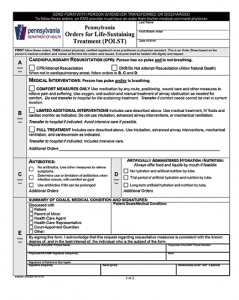Explore This Issue
ACEP Now: Vol 33 – No 08 – August 2014Understanding POLST forms will better enable emergency physicians to verify patients’ wishes for end-of-life care are being met
As the front line in care, emergency physicians often approach a patient in extremis or with a dramatic change in clinical condition. We may be presented with a Physician Orders for Life-Sustaining Treatment (POLST) form for a patient who has limited or no ability to communicate. Some background and cases will illustrate relevant considerations.1
What Is POLST?
The POLST form is part of a program to foster communication and shared decision making about goals of care at the end of life. The conversation is to occur between the patient or surrogate and a health care professional when the patient is diagnosed with a serious illness or frailty where the provider “would not be surprised if the patient died within the next year,” an outcome that is difficult to predict precisely.2,3 The health care professional documents the patient’s preferences as medical orders when the POLST form is completed.
Forty-three states currently have a fully endorsed or developing POLST program that is designed along the paradigm with shared core principles and similar form design.4 States may differ, however, in the terminology (eg, POLST, Physician Orders for Scope of Treatment [POST], Medical Orders for Life-Sustaining Treatment [MOLST], Medical Orders for Scope of Treatment [MOST]); color of the form (eg, bright pink, green, white, or copies); which health care professional is authorized to sign (eg, physician, nurse practitioner, physician assistant); whether the patient or surrogate must sign; action prompted by a blank section of the form; whether the program is delineated in statute, in regulation, or by a consensus panel; how to address a conflict between a POLST form and an advance directive; the degree of immunity; duty to comply; and the level of reciprocity with other states’ POLST programs. To understand many states’ specifics, visit the National POLST Paradigm’s website at www.polst.org.
Details of the POLST Form
Not all POLST forms are identical. The POLST form (see Figure 1) should include the patient’s name and authorized signatures of the health care provider and patient or surrogate. The top section, with a selection regarding resuscitation, applies if the patient is in cardiac arrest. The next sections usually describe goals of treatment, level of medical interventions, antibiotics, artificially administered hydration, and nutrition. The lower portion includes discussion of care goals.

Figure 1. POLST form for Pennsylvania, available at http://www.polst.org/educational_resource/pennsylvania-polst-form.
Pages: 1 2 3 | Single Page




No Responses to “Physician Orders for Life-Sustaining Treatment Forms: What You Need to Know”